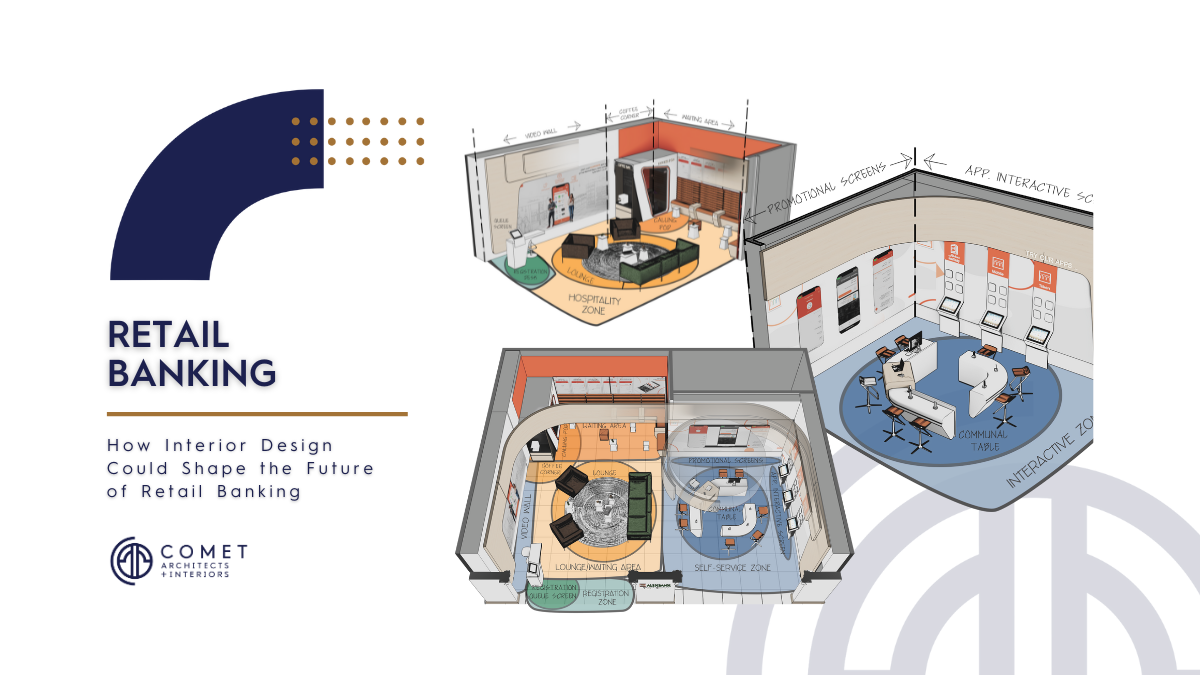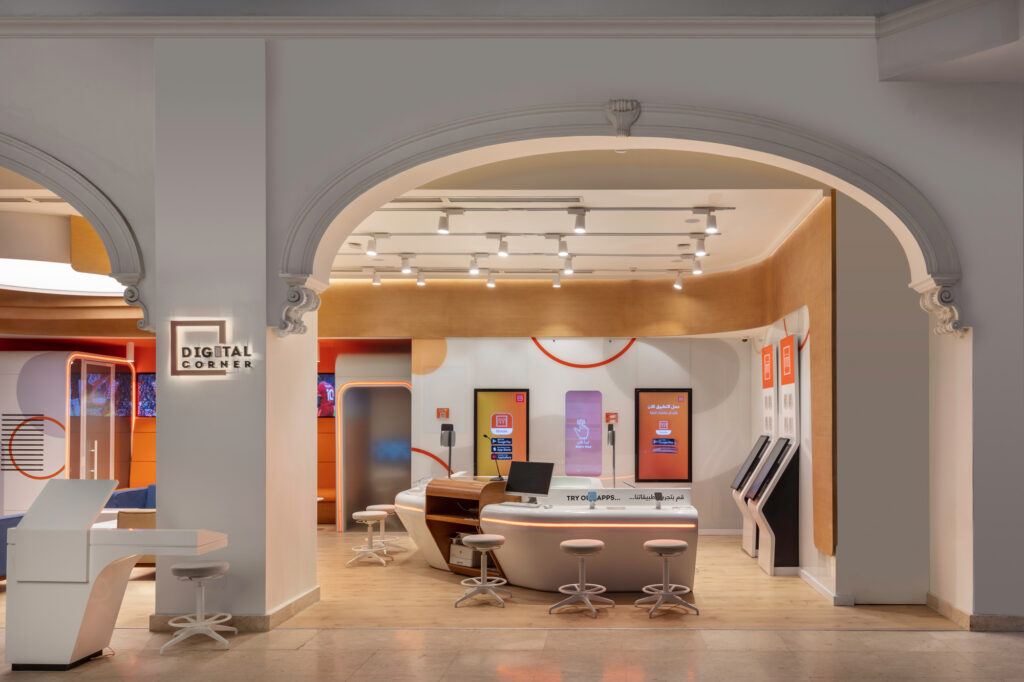How Interior Design Could Shape the Future of Retail Banking
- Home
- /
- Interior Design
- /
- How Interior Design Could Shape the Future of Retail Banking

How Interior Design Could Shape the Future of Retail Banking
In the ever-evolving digital landscape of today, where the pace of change is relentless, various industries, including banking, are recognizing the imperative to adapt and transform. This realization is particularly evident within the realm of retail banking, where the integration of technology has not only altered the way financial services are delivered but has also ushered in a new era of customer expectations and demands.

The “digital-first” approach has become a cornerstone for banks striving to offer a seamless and exceptional banking experience to customers across diverse markets. However, this digital transformation is not solely confined to technological advancements; it extends to the very physical spaces where banking transactions take place. This is where the compelling role of interior design comes into play, shaping the future of retail banking in profound and innovative ways.
The Need for a Banking Paradigm Shift
In recent years, the banking industry has faced increasing pressure to revolutionize its traditional approach. This impetus for change has been driven by the desire to meet the evolving needs of consumers in a rapidly changing world. Technological innovations, such as mobile and online banking, have certainly paved the way for more convenient and accessible financial services. However, the challenge remains to comprehensively update and enhance the overarching approach of banks.
One of the most crucial facets demanding attention is customer service. In today’s hyper-connected society, customers have come to expect a higher echelon of service that aligns with their modern lifestyles. Long wait times, cumbersome processes, and impersonal interactions no longer suffice. As such, the future of retail banking hinges on the ability of banks to create an environment that caters to these changing expectations.
Revolutionizing Retail Banking Through Interior Design
While the future of retail banking may appear daunting, the integration of innovative interior design principles offers a promising avenue for transformation. Banks are increasingly recognizing the significance of forging personalized relationships with their customers, transcending the transactional nature of traditional banking. Achieving this necessitates the creation of an environment that exudes warmth, comfort, and an air of approachability.
Interior design can facilitate this shift by fostering a relaxing ambiance that encourages meaningful interactions between customers and bank representatives. Strategic placement of inviting furniture, incorporation of soothing décor elements, and utilization of calming color palettes contribute to an atmosphere where clients feel at ease discussing their financial needs and aspirations.
Furthermore, the potential of interior design extends beyond aesthetics. The layout and spatial organization of bank branches can be optimized for efficiency, ensuring seamless customer flow and enhanced user experience. As banks endeavor to streamline operations and cut costs, a well-designed interior can contribute to resource optimization without compromising on service quality.
Cultivating Identity and Experience
In a saturated market replete with options, banks must strive to distinguish themselves from competitors. Herein lies another facet where interior design plays a pivotal role. By curating a distinctive and memorable interior environment, banks can carve out a unique identity that resonates with customers. Design elements that encapsulate the bank’s values, heritage, and commitment to innovation can captivate the imagination of both new and existing clients.
Harmonizing Digital Transformation with Physical Spaces
Amid the digital revolution, as banking interactions increasingly transcend physical boundaries, the importance of the physical banking environment remains undiminished. A harmonious fusion of technology and design is imperative. While stringent security measures are a cornerstone of banking operations, creating an environment that balances safety with comfort is paramount.
Strategic placement of security features, discreet integration of surveillance technology, and incorporation of design elements that promote transparency can collectively contribute to a secure yet inviting space. The symbiotic relationship between interior design and digital integration culminates in an environment where customers feel empowered, valued, and secure.
Embracing the Future of Retail Banking
As retail banking stands on the precipice of transformation, interior design emerges as a potent catalyst for change. By embracing design principles that prioritize customer experience, operational efficiency, and distinct identity, banks can unlock new realms of potential. The trajectory of retail banking is poised to evolve, and it is the synergy between innovative design and technological progress that will redefine the industry’s landscape.
In a world where digital interactions are paramount, the tangible realm of physical spaces remains irreplaceable. As banks journey towards an era of unprecedented digital engagement, the impact of interior design cannot be underestimated. It is the fusion of the virtual and the physical, the technological and the aesthetic, that will ultimately shape the future of retail banking. Through thoughtful consideration, strategic planning, and a commitment to enhancing customer experiences, banks can navigate this transformative journey and establish themselves as pioneers in a new era of banking excellence.
Innovating the Banking Landscape
The evolution of retail banking is not just a matter of adapting to technological shifts; it’s a multidimensional transformation that encompasses both the virtual and physical realms. The concept of interior design as a catalyst for this transformation underscores the holistic approach that banks need to adopt.
Consider the concept of “banking as an experience.” Banks are no longer just places for financial transactions; they are evolving into spaces where customers can engage, learn, and interact. Herein lies the pivotal role of interior design – to curate an environment that aligns with this evolving perception of banking.
Designing for Experience
Creating an inviting atmosphere is not just about choosing comfortable furniture and pleasant color schemes; it’s about orchestrating an experience. Imagine walking into a bank branch and being greeted by an open, well-lit space that exudes modernity and warmth. Interactive touchscreens allow customers to explore services, while cozy nooks invite them to engage in discussions with bank representatives. The design is not just a backdrop; it actively shapes the journey customers embark upon when they step inside.
Embracing Technological Integration
The future of retail banking pivots on seamless integration between the physical and digital worlds. Interior design must reflect this convergence. Charging stations for mobile devices, interactive displays showcasing the latest digital offerings, and strategically positioned QR codes for instant app downloads seamlessly bridge the gap between the tangible and the virtual.
Moreover, the very layout of the bank can be a testament to this integration. Imagine ergonomic workspaces where customers can comfortably engage in video consultations with financial advisors or access virtual reality tutorials on investment strategies. Interior design goes beyond aesthetics; it facilitates technology’s role as an enabler of customer empowerment.
Fostering Connection and Trust
Central to the future of retail banking is building lasting customer relationships rooted in trust. Interior design is not just about arranging furniture; it’s about fostering an environment where trust can flourish. The layout of private consultation rooms, soundproofed for confidentiality, ensures that sensitive conversations remain private. Thoughtfully placed artwork, inspired by the bank’s values, evokes a sense of authenticity and integrity.
Moreover, a well-designed space can be a testament to a bank’s commitment to sustainability and community. Incorporating eco-friendly materials, green spaces, and local artwork not only contribute to a visually appealing environment but also convey a sense of responsibility and shared values.
Adapting to Evolving Work Culture
The future of banking extends beyond transactional interactions; it encompasses the changing nature of work itself. With remote work becoming increasingly prevalent, banks are reimagining their branches as versatile spaces. Interior design can play a transformative role here, providing modular workstations, quiet zones for remote work, and technology-enabled meeting spaces. The bank’s physical space seamlessly adapts to the shifting demands of modern work culture.
Measuring Success Through Experience
As retail banking undergoes this metamorphosis, success can no longer be solely quantified by numbers. Customer satisfaction and engagement become paramount. Interior design is not merely an aesthetic endeavor; it’s a means of crafting experiences that drive customer loyalty and advocacy. The sense of comfort and empowerment customers feel within a well-designed bank can translate into positive word-of-mouth, social media endorsements, and ultimately, a competitive edge.
A Glimpse into the Future
Imagine stepping into a bank branch of the future. The entrance beckons with a blend of technology and nature – holographic displays showcasing financial trends intermingle with living plant walls. As you navigate the branch, you encounter interactive zones where virtual reality simulations provide hands-on financial education.
Consultation pods cocooned in acoustic comfort offer a quiet haven for personalized financial guidance, while collaborative spaces equipped with cutting-edge technology facilitate real-time portfolio reviews with remote experts. The café area invites customers to linger, offering not just refreshments, but also seminars on financial literacy.
This vision of the future is not just speculative; it’s a manifestation of how interior design could shape the future of retail banking. It’s a testament to the power of design to transcend the mundane and elevate the everyday – to transform a routine banking visit into an experience that leaves a lasting impact.
In this era of transformative change, the future of retail banking is a convergence of innovation, technology, and human-centric design. The interior design stands as a bridge, connecting the virtual and physical realms, and shaping the very essence of the banking experience. As banks seek to navigate the currents of change and reinvent themselves, the role of interior design emerges as a strategic imperative – a means of crafting a future where banking is not just about transactions, but about meaningful interactions, memorable experiences, and enduring relationships.
Ready to explore the future of banking? Visit our website to learn more about how innovative interior design is shaping the retail banking experience. Discover how we’re creating spaces that blend technology, comfort, and personalized service to redefine your banking interactions. If you’re ready to be a part of this transformative journey, don’t hesitate to contact us. Let’s craft a banking experience that goes beyond the ordinary.”
Recent Posts
- Designing Offices for Every Generation: Uniting Diverse Workforces
- Transform Your Store: 10 Expert Tips for Eye-Catching Retail Displays
- Redefining Collaboration: Innovative Meeting Room Designs for Modern Offices
- Break Rooms Reimagined: Creating Relaxation Retreats at Work
- Embracing the Circular Economy with Upcycling and Repurposing

